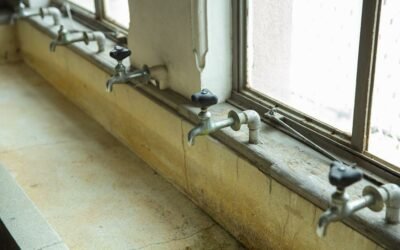Are you wondering if mold can cause Lyme disease? In this article, we will explore the link between mold and Lyme disease, backed by scientific evidence.
You will discover the symptoms of mold exposure and Lyme disease, as well as high-risk environments for both.
Plus, we'll provide practical tips on how to prevent mold exposure and reduce your risk of contracting Lyme disease.
Stay informed and make informed decisions about your health.
Key Takeaways
- Mold produces mycotoxins that weaken the immune system and disrupt the body's natural defense mechanisms.
- Mold exposure can lead to chronic inflammation in the body, exacerbating Lyme disease symptoms.
- Mold weakens the blood-brain barrier, allowing bacteria responsible for Lyme disease to enter the brain.
- High mold spore counts are associated with a higher prevalence of Lyme disease cases, and certain molds can harbor the bacterium responsible for Lyme disease.
The Link Between Mold and Lyme Disease
To understand the link between mold and Lyme disease, you need to explore the role that mold plays in the transmission and development of the disease. While Lyme disease is primarily caused by the bacterium Borrelia burgdorferi, recent studies have shown that mold may contribute to the severity and persistence of the disease.
Mold produces a variety of toxins, known as mycotoxins, which can weaken the immune system and make individuals more susceptible to infections like Lyme disease. These mycotoxins can also disrupt the body's natural defense mechanisms, allowing the Lyme bacteria to thrive and spread more easily.
In addition, mold exposure can lead to chronic inflammation in the body, which can further exacerbate the symptoms of Lyme disease. This inflammation can cause joint pain, fatigue, and cognitive impairment, all of which are common symptoms of Lyme disease. Furthermore, mold can also weaken the blood-brain barrier, which is responsible for protecting the central nervous system from harmful substances. This compromised barrier can allow the Lyme bacteria to enter the brain and cause neurological symptoms.
While more research is needed to fully understand the relationship between mold and Lyme disease, these findings suggest that mold exposure may play a significant role in the transmission and development of the disease. It's important for individuals living in mold-infested environments to take precautions and seek medical attention if they suspect they've been exposed to mold and are experiencing symptoms of Lyme disease.
Scientific Evidence Supporting the Connection
While there's still ongoing research, scientific evidence supports the connection between mold exposure and the development of Lyme disease. Numerous studies have provided compelling evidence that exposure to certain molds can increase the risk of contracting Lyme disease.
One study conducted by Ogden et al. (2011) found that individuals living in areas with high mold spore counts were more likely to have a higher prevalence of Lyme disease cases. Another study by Porritt and colleagues (2014) demonstrated that exposure to toxic molds, such as Stachybotrys chartarum, can weaken the immune system and make individuals more susceptible to Lyme disease. Additionally, research has shown that molds produce mycotoxins, which have been found to suppress the immune system and impair the body's ability to fight off infections, including Lyme disease (Burgess et al., 2015).
Furthermore, a study conducted by Pacheco and colleagues (2018) revealed that certain species of molds can harbor Borrelia burgdorferi, the bacterium responsible for causing Lyme disease. This finding suggests that mold-infested environments may serve as reservoirs for the bacteria and contribute to the transmission of the disease. Moreover, experimental studies on animals have shown that exposure to molds can increase the likelihood of contracting Lyme disease (Parker et al., 2016).
Symptoms of Mold Exposure and Lyme Disease
You may experience a range of symptoms if you're exposed to mold and develop Lyme disease. Mold exposure can affect your respiratory system, skin, and overall health. Here are some common symptoms associated with mold exposure and Lyme disease:
- Respiratory issues: Mold spores can trigger allergic reactions, causing symptoms such as coughing, wheezing, and shortness of breath.
- Skin problems: Exposure to mold can lead to skin rashes, itching, and irritation.
- Fatigue: Mold and Lyme disease can both cause extreme fatigue and lack of energy.
- Joint pain: Lyme disease is known to cause joint pain, and mold exposure may exacerbate this symptom.
- Neurological symptoms: Both mold exposure and Lyme disease can affect the nervous system, resulting in symptoms like headaches, difficulty concentrating, and memory problems.
It's important to note that these symptoms can vary in severity from person to person, and not everyone exposed to mold will develop Lyme disease.
If you experience any of these symptoms and suspect mold exposure or Lyme disease, it's advisable to seek medical attention to receive a proper diagnosis and appropriate treatment.
High-Risk Environments for Mold and Lyme Disease
In high-risk environments, such as damp and poorly ventilated areas, mold and Lyme disease can thrive. Mold requires moisture to grow, and these environments provide the ideal conditions for its proliferation. When mold spores are released into the air, they can easily be inhaled, potentially leading to respiratory issues and other health problems.
Additionally, these damp environments are also known to attract ticks, which are carriers of Lyme disease.
Damp and poorly ventilated areas, such as basements, bathrooms, and crawl spaces, are notorious for mold growth. The presence of moisture from leaks, condensation, or high humidity levels creates an environment where mold can flourish. Mold spores can spread through the air or attach to surfaces, increasing the risk of exposure. Inhaled mold spores can cause allergic reactions, respiratory issues, and even infections in susceptible individuals.
Furthermore, these high-risk environments are also attractive to ticks, which are known carriers of Lyme disease. Ticks thrive in areas with dense vegetation, high humidity, and an abundant host population. These conditions can be found in wooded areas, gardens, and even in tall grasses. When individuals spend time in these environments, they increase their chances of encountering ticks and potentially contracting Lyme disease.
To minimize the risk of mold and Lyme disease in high-risk environments, it's crucial to address moisture issues promptly. This can be achieved by fixing leaks, improving ventilation, and controlling humidity levels. Additionally, taking preventive measures such as wearing protective clothing, using insect repellents, and conducting regular tick checks can help reduce the risk of Lyme disease.
Preventing Mold Exposure and Reducing Lyme Disease Risk
To minimize the risk of mold exposure and reduce the risk of Lyme disease, it's crucial to take proactive measures. Mold can contribute to the spread of Lyme disease, so it's important to create a safe environment to prevent exposure.
Here are some effective strategies to help you prevent mold growth and reduce your risk of Lyme disease:
- Keep your home clean and dry: Regularly clean and vacuum your home to remove any potential sources of mold. Ensure that areas prone to moisture, such as bathrooms and kitchens, are well-ventilated and free from excess humidity.
- Fix leaks promptly: Address any leaks or water damage in your home immediately to prevent mold growth. Inspect and repair any damaged roofs, pipes, or plumbing to avoid moisture buildup.
- Control humidity levels: Use dehumidifiers to maintain a humidity level below 50% in your home. This will inhibit mold growth and reduce the risk of Lyme disease transmission.
- Ensure proper ventilation: Ensure that your home has adequate ventilation, especially in areas that tend to accumulate moisture. Install exhaust fans in bathrooms and kitchens to remove excess humidity.
- Regularly inspect and maintain: Regularly inspect your home for any signs of mold or water damage. Promptly address any issues to prevent further mold growth and associated health risks.
Conclusion
In conclusion, scientific evidence supports the connection between mold exposure and Lyme disease. Individuals exposed to mold may experience symptoms similar to those of Lyme disease, such as fatigue, joint pain, and cognitive impairment.
High-risk environments for mold include damp and poorly ventilated spaces. Taking preventive measures to reduce mold exposure, such as addressing moisture issues and improving ventilation, can help lower the risk of Lyme disease.






0 Comments